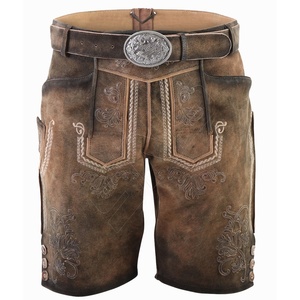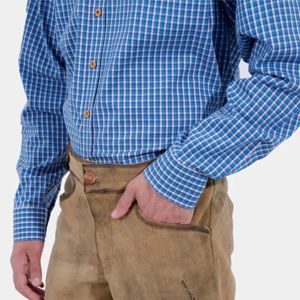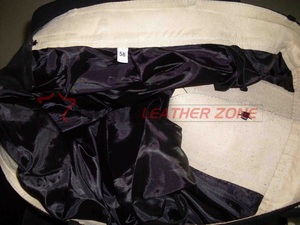(540 products available)






































































































































































































Bavarian trousers are essentially a type of traditional Bavarian and Alpine male knee-length trousers. They are well known for their distinctive embroidery and leather-made variants. They are popular in Bavaria, which is a German region, and in some parts of Austria as well. Here are some of their common types:
Bundhosen
These are Bavarian traditional trousers, which are usually worn during festivities and are a common sight in traditional Bavarian garb. They are usually knee-length and are accompanied by socks and shoes. Bundhosen are mostly made from fabrics such as corduroy, wool, or cotton. These materials are comfortable and offer warmth. They often come with elaborate embroidery on the pockets, straps, and legs, indicating regional or familial connections. This kind of clothing serves both functional and aesthetic purposes, providing ease of movement and incorporating cultural symbols of the wearer's heritage or community.
Lederhosen
These are leather-made Bavarian trousers that are commonly worn in the southern regions of Germany and parts of Austria. They are mostly associated with the male gender; however, they have also been adopted by women in some cases. These trousers are usually short, and they reach the knee and are accompanied by a pair of suspenders. They are mostly made from tanned deer skin and come with elaborate designs and embroidery. Lederhosen have a historical background dating back to the 16th century when they were worn as working clothes by farmers and laborers. They are now a symbol of Bavarian culture and are popularly worn during festivals, parades, and other folk events. They are a representation of regional heritage and craftsmanship.
Kniebundhosen
These are a traditional form of knee-length trousers that are mostly worn in the Bavarian region of Germany and across parts of Austria and Switzerland. The name translates to "knee-bund trousers," which is a description of their characteristic style, which involves reaching the knees and being tied just below them. Kniebundhosen are normally made from robust materials such as wool or cotton and are commonly worn with knee-length socks that are rolled down to the calves. They are popularly worn during folk events and are a part of the traditional garb in these areas. They are a symbol of cultural identity and are a representation of the regional adaptation of clothing fashions.
Trachtenhosn
These are traditional Bavarian trousers that are commonly worn in the southern regions of Germany and parts of Austria. They are mostly knee-length and are usually accompanied by a pair of suspenders. Trachtenhosen are usually made from fabrics such as wool, cotton, or corduroy, and they come with elaborate decorations and embroidery that have cultural and regional significance. They may also be found in various styles, including short and long versions. They are a common sight during folk events, festivals, and other cultural celebrations in the region. They are a representation of the rich heritage and customs of the Bavarian people.
Bavarian Trousers have various designs, which makes them unique and ideal for different occasions. Here are some of the designs:
Bavarian trousers, known for their distinctive style and cultural significance, offer various wearing and matching suggestions to create versatile and appealing outfits. For a traditional look, pairing lederhosen with a crisp white or checkered button-down shirt is essential. Opt for a shirt with rolled-up sleeves to add a touch of casual charm. Completing the outfit, traditional Bavarian shoes, known as Haferl shoes, or sturdy boots, enhance the rustic aesthetic. Adding knee-length socks with patterns or embroidery further accentuates the authentic Bavarian style. A felt hat adorned with a feather or floral decoration can provide an extra cultural touch, making this ensemble perfect for Oktoberfest celebrations or folk festivals.
For a modern twist on Bavarian lederhosen, consider pairing them with a fitted, solid-colored t-shirt or a lightweight sweater. Choose neutral or muted tones like gray, navy, or olive to create a contemporary and understated look. Rolled-up sleeves or tucking the shirt slightly can add a relaxed vibe. Footwear can vary from casual sneakers for a laid-back appearance to leather loafers for a more polished finish. A slim belt and minimalistic accessories, such as a watch or bracelet, can complement the outfit without overwhelming it. This combination seamlessly transitions from daytime activities to evening outings, offering comfort and style.
Women’s Bavarian trousers, often styled as lederhosen-inspired shorts with suspenders, can be beautifully paired to embrace both tradition and modern fashion. Choose a blouse or a fitted, slightly cropped top that complements the color of the shorts. Blouses with lace or embroidery can add a romantic touch, while solid-colored tops keep the look chic and simple. Pair these shorts with knee-length tights or socks, which not only keep the legs warm but also contribute to the classic Bavarian aesthetic. Opt for traditional shoes or ankle boots to complete the look. Accessories like a delicate necklace, bracelets, and a stylish hat can enhance the outfit, making it suitable for various occasions, from outdoor festivals to casual gatherings.
Q1: What distinguishes Bavarian trousers from other types of traditional regional pants in Germany?
A1: Bavarian trousers stand out due to their distinctive features, such as elaborate embroidery, a short length ending just below the knee (in the case of Lederhosen), and the use of durable leather or sturdy fabrics. Unlike other regional pants, Bavarian trousers often include decorative elements like suspenders with embroidered designs, making them both functional and aesthetically unique.
Q2: Are Bavarian trousers worn year-round, or are they specific to certain seasons and events?
A2: Bavarian trousers, especially Lederhosen, are worn year-round, but their popularity peaks during festivals like Oktoberfest. They are suitable for various occasions, from everyday wear in rural areas to special events and celebrations. Depending on the material, they can be warmer leather styles for cooler seasons or lighter fabrics for milder weather.
Q3: How do Bavarian trousers incorporate modern fashion trends while retaining their traditional essence?
A3: Modern adaptations of Bavarian trousers may include variations in fit, such as slimmer or more tailored silhouettes, and the use of contemporary fabrics while retaining traditional elements like embroidery and leather options. Designers often balance tradition and modernity by incorporating traditional motifs into stylish, versatile designs appealing to a broader audience.
Q4: Can women wear Bavarian trousers, and are there specific styles designed for them?
A4: Yes, women can wear Bavarian trousers, and there are styles designed specifically for them, often featuring similar traditional elements like embroidery but tailored for a women's fit. These can include cropped versions or styles that accommodate a woman's body while maintaining the cultural and aesthetic aspects of Bavarian trousers.